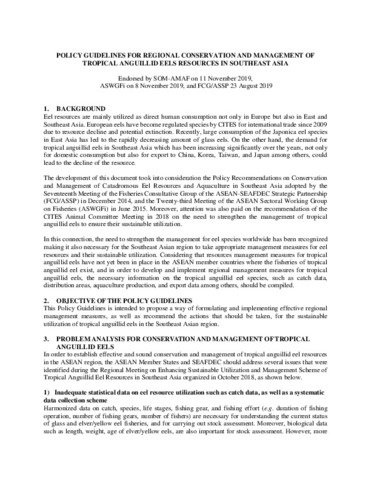Policy Guidelines for Regional Conservation and Management of Tropical Anguillid Eels Resources in Southeast Asia
Share
Abstract
Eel resources are mainly utilized as direct human consumption not only in Europe but also in East and Southeast Asia. European eels have become regulated species by CITES for international trade since 2009 due to resource decline and potential extinction. Recently, large consumption of the Japonica eel species in East Asia has led to the rapidly decreasing amount of glass eels. On the other hand, the demand for tropical anguillid eels in Southeast Asia which has been increasing significantly over the years, not only for domestic consumption but also for export to China, Korea, Taiwan, and Japan among others, could lead to the decline of the resource.
The development of this document took into consideration the Policy Recommendations on Conservation and Management of Catadromous Eel Resources and Aquaculture in Southeast Asia adopted by the Seventeenth Meeting of the Fisheries Consultative Group of the ASEAN-SEAFDEC Strategic Partnership (FCG/ASSP) in December 2014, and the Twenty-third Meeting of the ASEAN Sectoral Working Group on Fisheries (ASWGFi) in June 2015. Moreover, attention was also paid on the recommendation of the CITES Animal Committee Meeting in 2018 on the need to strengthen the management of tropical anguillid eels to ensure their sustainable utilization.
In this connection, the need to strengthen the management for eel species worldwide has been recognized making it also necessary for the Southeast Asian region to take appropriate management measures for eel resources and their sustainable utilization. Considering that resources management measures for tropical anguillid eels have not yet been in place in the ASEAN member countries where the fisheries of tropical anguillid eel exist, and in order to develop and implement regional management measures for tropical anguillid eels, the necessary information on the tropical anguillid eel species, such as catch data, distribution areas, aquaculture production, and export data among others, should be compiled.

